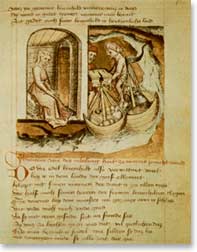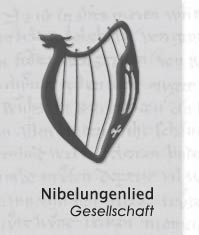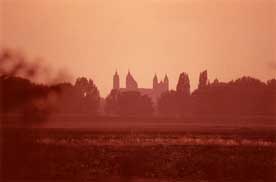|
The
Nibelungenlied
and Worms
from Ulrike Schäfer
|
.... |
Cathedral, Worms, Photo by Heinz Angermüller ..
|
The poet who lived at the end of the 12th century knew Worms
This is the Romanesque Worms Cathedral with its four round, tall towers. Although it had several precursors, the first one of which was built in the 7th century, it took its current shape when Frederick I was Holy Roman emperor (that was from 1152 - 1190. Frederick, also known as Barbarossa, liked to reside in Worms
and he had it converted into a splendid town. There is quite some evidence that the red-bearded Hohenstaufen king was in attendance when the Cathedral was inaugurated in 1181. His son Henry VI, who was king from 1184 and became ruler after Frederick's death in 1190, was also in Worms quite frequently. This is the very scenery the anonymous poet must have had in mind when in 1200 he wrote the Nibelungenlied. The first part of the epic is mainly set in Worms. Some 30 references to the city and its vicinity can be found in Manuscript C, which is the oldest of a total of 36 manuscripts written between 1220 and 1450.
The city is repeatedly mentioned as being situated on the river Rhine; ships arriving would berth "on the Sand", so the poet must have been familiar with the flat banks of the Rhine, which were a good deal away from the city.
 |
.... |
When he wrote about a large number of towers in the city, he certainly did not only mean the churches, but also the city battlements. Frederick had them reinforced by adding walks on their top and had them moved further towards the Rhine. The author also frequently mentions the king's castle, the place where king Gunther lived with his brothers Gernot and Giselher and his sister Kriemhild.
This model gives you an impression of how the Cathedral's surroundings and the magnificent emperor's palace might have looked in those days. The Cathedral was directly accessible from the castle. In the Cathedral's walls you can still see the breaks where the castle adjoined the church.
Der Hort kommt nach Worms, Hundeshagen-Handschrift, 15 Jh.
|
The staircase leading to the banqueting hall is mentioned in connection with the double wedding of king Gunther with Brunhild and Siegfried with Kriemhild. The castle was destroyed, rebuilt at a bishop's Palace and destroyed onceagain, for the last time? The place in front of the North Porch is the scene where the two queens had their grave quarrel.
|



